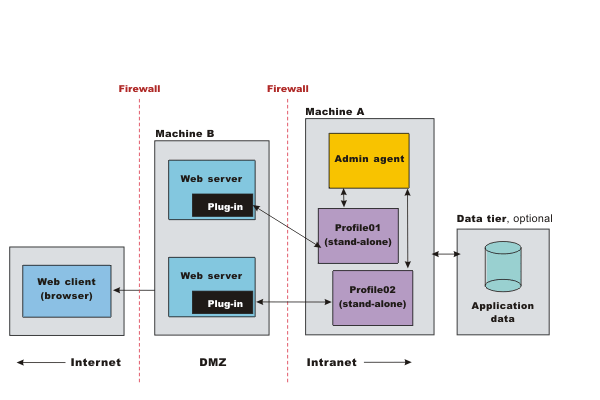Administrative agent
An administrative agent provides a single interface to administer multiple unfederated application server nodes in environments such as development, unit test or that portion of a server farm that resides on a single machine.
The administrative agent and application servers must be on the same machine, but we can connect to the machine from a browser or wsadmin.sh on another machine.
(zos) The administrative agent and application servers must be on the same sysplex, but we can connect to the sysplex from a browser or wsadmin.sh on another machine.
Multiple customers administer application servers in their development, test, and production environments by federating the application server nodes into a cell and administering the application servers from the deployment manager. However, if we have development and unit test environments, then you might prefer to run application servers whose nodes have not been federated. These application servers have some administrative disadvantages. The application servers lack a common administrative interface. Remote administration is limited to installing applications and changing application server configurations. Alternatively, we can register these application servers with an administrative agent to administer application servers from a single interface and to more fully administer application servers remotely.
We can register an application server node with the administrative agent or federate the node with a deployment manager, but not both.
Avoid trouble: Registered nodes must have the same products as the administrative agent, and the products must be at the same version levels on the registered node and the administrative agent. This requirement is enforced because the administrative agent must have a matching environment in order to handle all of the administrative capabilities of the registered node. A node is not allowed to register with an administrative agent unless that node has an identical set of products and versions. gotcha
transition: If we were previously running on Version 7.0.0.11 or earlier, and have an administrative agent with a managed node that has mismatched products or versions, when you when you migrate to Version 8.0, that administrative agent will not be able to start the subsystem for any mismatched nodes. We must update these nodes to have the same products and versions as the administrative agents, restart the servers on the node and then restart the administrative agent, before the administrative agent can resume managing these registered nodes
An administrative agent can monitor and control multiple application servers on one or more nodes. Use the application servers only to run the applications. By using a single interface to administer the application servers, you reduce the overhead of running administrative services in every application server.
We can use the administrative agent to install applications on application servers, change application server configurations, stop and restart application servers, and create additional application servers.
(zos) We can start the administrative agent on any logical partitions (LPAR) if the administrative agent configuration is on a shared file system.
Example topology of multiple application servers managed by an administrative agent
The following example topology shows machine A with an administrative agent and two application servers, Profile01 and Profile02, that are registered with the administrative agent. The application servers on machine A each communicate with a remote web server on machine B through the web server plug-in. Firewalls provide additional security for the machines. Read the topic on planning to install WebSphere Application Server for further information on the topology.

Administrative jobs for application servers
registered to an administrative agent and for deployment managers
We can use a job manager to submit administrative jobs asynchronously for application servers registered to an administrative agent and for deployment managers. To make application servers registered to an administrative agent and deployment managers known to the job manager, you must register them with the job manager. Many of the management tasks that we can perform with the job manager are tasks that we can already perform with the product, such as application management, server management, and node management. However, with the job manager, we can aggregate tasks and perform those tasks across multiple application servers or deployment managers.
Related concepts
Related tasks